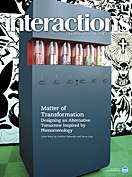Authors:
Jeffrey Bardzell, Shaowen Bardzell
In recent years, interaction designers and researchers have shown a rising interest in practices in which designers create designs not to be sold in the marketplace, but rather to interrogate possible futures, critique the (designed) present, develop design concepts, and/or explore people's attitudes toward and needs for future designs. Some terms that have been introduced to describe different aspects of this strategy include critical design, adversarial design, speculative design, constructive design, design fictions, and research through design. As these practices continue to gain traction, some basic questions emerge. For critical design, for example, we might ask: Is this design…
You must be a member of SIGCHI, a subscriber to ACM's Digital Library, or an interactions subscriber to read the full text of this article.
GET ACCESS
Join ACM SIGCHIIn addition to all of the professional benefits of being a SIGCHI member, members get full access to interactions online content and receive the print version of the magazine bimonthly.
Subscribe to the ACM Digital Library
Get access to all interactions content online and the entire archive of ACM publications dating back to 1954. (Please check with your institution to see if it already has a subscription.)
Subscribe to interactions
Get full access to interactions online content and receive the print version of the magazine bimonthly.






